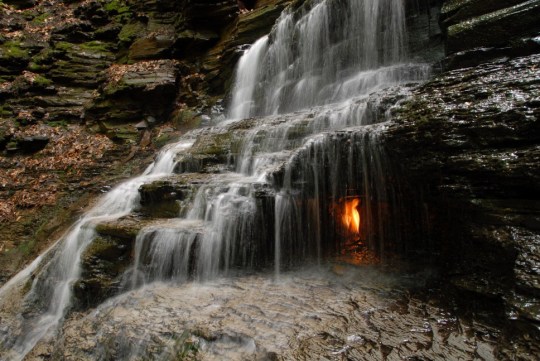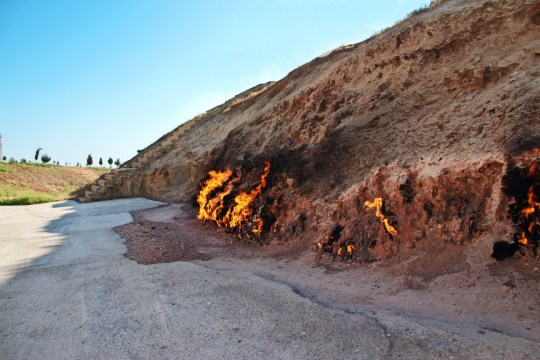In a New York park, just outside Buffalo, a waterfall has been drawing tourists like moths to a flame. Literally.
It isn’t Niagara, the roaring, foaming monster just north of the city. In comparison, this waterfall is just a trickle, a leaky tap to Niagara’s fire hose.
But it has something Niagara doesn’t.
It hides one of the world’s ‘eternal flames’. Just as the name suggests, these intriguing fires are almost impossible to extinguish, and are found across the globe.
Some are big, like the ‘Gates of Hell’ in Turkmenistan. Some are small, like the blue flame of India’s Jwala Ji temple. But they burn away, night and day, minding their own business – some for possibly thousands of years.
All are natural in origin, fuelled by a never-ending supply of gas, coal or oil seeping out from Earth’s crust.
How they came to be ignited however is often a mystery. It could have been a lightning strike, or perhaps a wildfire. Many have been deliberately lit however, often as a symbol of religious or historical significance.
Because of their nature, and often small size, there could be others we have yet to discover, but those we do know about provide more than enough fascination for now.
Darvaza, Turkmenistan
Arguably the most famous, the Darvaza gas crater has been burning since the 1980s. Its enormous size – 70 metres wide and 30 metres deep – combined with the roar of thousands of fires within, has earned it the nickname ‘the Gates of Hell’.
While no one is quite sure how the crater itself formed, the gas leaking out of it was lit by Soviet engineers in order to ‘burn it off’.
Unfortunately, given the crater is set in a gas field, that will take some time to do, and so four decades on, the fire continues to rage.
Chestnut Ridge Park, US
The Eternal Flame Falls in New York state overtook its neighbour Niagara in terms of fame in January when a TikTok showing the tiny flame flickering behind a stream of crystal clear water went viral.
The flame is fuelled by a small methane leak in the rocks and, according to a study in 2013, ‘may have burnt naturally for many hundreds or even thousands of years’.
Guanziling, Taiwan
In a small pool near Taiwan’s Guanziling hot springs, the water appears as if on fire.
Known as the Fire and Water Spring, it was discovered in 1701 by a Fujianese monk. Various legends surround the fire, including one in which the hot spring water is urine from a creature known as Kirin, which it set alight to entertain people.
Olympos National Park, Turkey
The flames of Chimera are found on the slopes of Mount Olympos, or Tahtalı Dağı, in southern Turkey.
Known in Turkish as Yanartaş, or ‘Burning Rock’, it is a small cluster of flames thought in ancient times to be the breath of a monster – or chimera – that was part lion, part snake and part goat that terrorised the people of Lycua.
Digah, Azerbaijan
Not all naturally occurring flames burn forever. In the 13th century Marco Polo recorded numerous natural gas flames in the Abşeron Peninsula, but today only one remains, Yanar Dağ.
Roughly ten metres long, it emerges at the foot of Fire Mountain – a name heavy in poetic licence for a small hill. While some say it has burnt for thousands of years, others say it was reignited by a discarded cigarette in the 1950s.
Himachal Pradesh, India
In northwest India, bordering Tibet, the state of Himachal Pradesh is home to the Jwala Ji Temple, home to an eternal gas flame that has been burning for more than a century.
In Hindu mythology, one popular legend behind the flame says it is the ‘fiery tongue of the goddess Sati’, whose body parts were scattered across the Indian subcontinent. The flame, the manifestation of the goddess, marks her spiritual presence.
Jomsom, Nepal
Just out of the city of Jomsom in Nepal, in the Himalayas, The Muktinath Temple is revered as a place on Earth that hosts fire, water, earth and air in naturally occurring materials.
This ancient place is sacred for both Hindus and Buddhists as it’s home to an eternal flame that has been burning for more than 2000 years. It is said that the Hindu god Brahma lit the flame, and it has been burning ever since.
Murchison, New Zealand
In the South Island village of Murchison, in the Blackwater River, the air is tinged with the smell of kerosene. The locals dub it the Gas Blows.
Here, an eternal flame burns away in a bright yellow smokeless flame in a bush near the river, feeding off a natural methane gas leak from the ground.
It is believed the fire has been burning since the 1920s, and originated when a hunter threw away his match and ignited the leaking gas next to him.
Kirkuk, Iraq
Near the Iraqi city of Kirkuk, an oil field was discovered in 1927 – but before then the region was famous for its eternal flame.
Known as Baba Gurgur, the field’s name may derive from the Kurdish word for Father (baba), and ‘Kur’ meaning fire.
Some Bible scholars believe Baba Gurgur is in fact the ‘fiery furnace’ into which Abednego, Shadrach and Meshach were thrown in the Old Testament.
Jharia, India
The Jharia coalfield stretches around 110 square miles, and is the main source of India’s coal.
Not all can be mined however, because it is already burning, having been set alight in 1916.
The flames have consumed around 37 million tons of coal, causing significant ground subsidence and water and air pollution in local communities – leading to severe health problems such as breathing disorders and skin diseases.
Centralia, US
Beneath abandoned coal mines lies an eternal coal-seam fire in the borough of Centralia, Pennsylvania.
No one knows how it started, but it has been burning since at least 1962.
But peer into the seam and it glows down to 90m deep, stretching for more than 13km. At it’s current rate, it is estimated to burn for over 250 years.
Laurel Run, US
We’ve all made mistakes at work. Most don’t have ramifications that last a couple of centures.
But when a miner in Red Ash Coal miner left his gas lamp behind on a Friday night, by Monday morning the coal field was alight. It still is today, and probably will be for another 100 years.
The site is also known as ‘the burning mountain’ due to the smoke venting from fissures around the area.
New Straitsville, US
When it comes to setting a coal mine on fire it’s one thing to forget your lamp, quite another to deliberately push flaming mine cars into the belly of the beast.
But that’s exactly what happened during the 1884 New Straitsville strike when a group of six miners, deciding that if they couldn’t work no one should, took drastic action, lighting the mine on fire.
At times, the fire could be seen for five miles as it soared 30 metres in the air, and the soil would get so hot that, apparently, roses bloomed in winter and potatoes baked in the ground.
It still burns to this day.
Mount Wingen, Australia
Geologists believe that the coal smouldering beneath Mount Wingen in New South Wales, Australia, has been alight for around 6,000 years, making it the world’s oldest known coal fire.
No surprise then that it has earned the nickname Burning Mountain.
It is thought the Aborigines named the mountain Wingen, which means ‘fire’. Legend says that one day, a tribesman was lighting a fire on the side of the mountain when he was snatched by The Evil One and carried off into the deep. Unable to escape, he set the mountain alight in the hope the smoke might keep others away.
Today, the fire is move south at around a metre a year.
MORE : UK scientists are creating the world’s first lung cancer vaccine
MORE : The face of a 500-year-old vampire with a brick between her teeth
MORE : A new ‘brain glue’ inspired by slug slime could transform neurosurgery
Get your need-to-know
latest news, feel-good stories, analysis and more
This site is protected by reCAPTCHA and the Google Privacy Policy and Terms of Service apply.


















